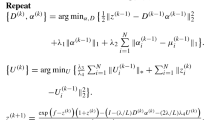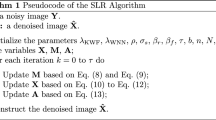Abstract
Recently, due to smooth rank function generally lie much closer to essential rank function than existing methods, it was used to handle matrix completion problem. In this paper, a new approach for solving low-rank matrix recovery problem based on smooth function is proposed. It not only uses a smooth function to approximate the rank function, but also approximates the \(l_{0}\)-norm with a continuous and differentiable function. In addition, gradient decreasing approach is used to solve the minimization problem. Finally, experimental results show that our proposed algorithm provides a higher accurate in most cases with reasonable running time. Especially, it has higher approximation performance than other methods for additive Gaussian noise, Rayleigh noise, and mixed noise of Gaussian and salt and pepper noise.








Similar content being viewed by others
References
Li XL, Pang YW (2010) Deterministic column-based matrix decomposition. IEEE Trans Knowl Data Eng 22(1):145–149
Yuan Y, Li XL, Pang YW, Lu X, Tao DC (2009) Binary sparse nonnegative matrix factorization. IEEE Trans Circuits Syst Video Technol 19(5):772–777
Ji TY, Huang TZ, Zhao XL, Ma TH, Liu G (2016) Tensor completion using total variation and low-rank matrix factorization. Inf Sci 326:243–257
Boumal N, Absil PA (2015) Low-rank matrix completion via preconditioned optimization on the Grassmann manifold. Linear Algebra Appl 475:200–239
Hu SQ, Wang J (2003) Absolute exponential stability of a class of continuous-time recurrent neural networks. IEEE Trans Neural Netw 14(1):35–45
Wang XZ, Aamir R, Fu AM (2015) Fuzziness based sample categorization for classifier performance improvement. J Intell Fuzzy Syst 29:1185–1196
Wang XZ, Shao QY, Qing M, Zhai JH (2013) Architecture selection for networks trained with extreme learning machine using localized generalization error model. Neurocomputing 102:3–9
Liu GC, Lin ZC, Yan SC, Sun J, Yu Y, Ma Y (2013) Robust recovery of subspace structures by low-rank representation. IEEE Trans Pattern Anal Mach Intell 35(1):171–184
Peng YG, Suo JL, Dai QH, Xu WL (2014) Reweighted low-rank matrix recovery and its application in image restoration. IEEE Trans Cybern 44(12):2418–2430
Lai ZH, Wong WK, Xu Y, Yang J, Zhang D (2016) Approximate orthogonal sparse embedding for dimensionality reduction. IEEE Trans Neural Netw 27(4):723–735
Hong CQ, Yu J, Wan J, Tao DC, Wang M (2015) Multimodal deep autoencoder for human pose recovery. IEEE Trans Image Process 24(12):5659–5670
Hu SQ, Wang J (2001) Quadratic stabilizability of a new class of linear systems with structural independent time-varying uncertainty. Automatica 37(1):51–59
Wang XZ, Xing HJ, Li Y et al (2015) A study on relationship between generalization abilities and fuzziness of base classifiers in ensemble learning. IEEE Trans Fuzzy Syst 23(5):1638–1654
Wang XZ, Wang R, Feng HM, Wang HC (2014) A new approach to classifier fusion based on upper integral. IEEE Trans Cybern 44(5):620–635
Wang XZ, Dong LC, Yan JH (2012) Maximum ambiguity based sample selection in fuzzy decision tree induction. IEEE Trans Knowl Data Eng 24(8):1491–1505
Wright J, Ganesh A, Rao S, Peng YG, Ma Y (2009) Robust principal component analysis: exact recovery of corrupted low-rank matrices. In: Proceedings of neural information processing systems, pp 1–9
Deng Y, Liu YB, Dai QH, Zhang Z, Wang Y (2012) Noisy depth maps fusion for multiview stereo via matrix completion. IEEE J Sel Topics Signal Process 6(5):566–582
Ma R, Barzigar N, Roozgard A, Cheng S (2014) Decomposition approach for low-rank matrix completion and its applications. IEEE Trans Signal Process 62(7):1671–1683
Huang C, Ding XQ, Fang C, Wen D (2014) Robust image restoration via adaptive low-rank approximation and joint kernel regression. IEEE Trans Image Process 23(12):5284–5297
Chistov AL, Grigoriev DY (1984) Complexity of quantifier elimination in the theory of algebraically closed fields. In: Proceedings of 11th symposium Praha, Mathematical Foundations of Computer Science, 176, pp 17–31
Fazel M, Hindi H, Boyd SP (2003) Matrix rank minimization with applications. In: Proceedings of the American Control Conference, pp 2156–2162
Candès EJ, Plan Y (2010) Matrix completion with noise. Proc IEEE 98(6):925–936
Mohan K, Fazel M, Hassibi B (2011) A simplified approach to recovery conditions for low rank matrices. In: Proceedings of international symposium on information theory (ISIT), pp 2318–2322
Candès EJ, Li XD, Ma Y, Wright J (2011) Robust principal component analysis? J ACM 58(3):1–37
Cai JF, Candès EJ, Shen ZW (2010) A singular value thresholding algorithm for matrix completion. SIAM J Optim 20(4):1956–1982
Lin ZC, Chen MM, Ma Y (2009) The augmented lagrange multiplier method for exact recovery of corrupted low-rank matrices, Dept. Elect. Comput. Eng., Univ. Illinois, Urbana, IL, USA, Tech. Rep., uilueng-09-2215
Ma SQ, Goldfarb D, Chen LF (2011) Fixed point and bregman iterative methods for matrix rank minimization. Math Program 128(1):321–353
Wen ZW, Yin WT, Zhang Y (2012) Solving a low-rank factorization model for matrix completion by a nonlinear successive over-relaxation algorithm. Math Program Comput 4(4):333–361
Parker JT, Schniter P, Cevher V (2014) Bilinear generalized approximate message passing. IEEE Trans Signal Process 62(22):5839–5853
Keshavan RH, Montanari A, Oh S (2010) Matrix completion from a few entries. IEEE Trans Inf Theory 56(6):2980–2998
Lee K, Bresler Y (2010) Admira: atomic decomposition for minimum rank approximation. IEEE Trans Inf Theory 56(9):4402–4416
Needell D, Tropp JA (2009) Cosamp: iterative signal recovery from incomplete and inaccurate samples. Appl Comput Harmon Anal 26(3):301–321
Mohimani H, Babaie-Zadeh M, Jutten C (2009) A fast approach for overcomplete sparse decomposition based on smoothed \(\ell ^{0}\) norm. IEEE Trans Signal Process 57(1):289–301
Malek-Mohammadi M, Babaie-Zadeh M, Amini A, Jutten C (2014) Recovery of low-rank matrices under affine constraints via a smooth rank function. IEEE Trans Signal Process 62(4):981–992
Ghasemi H, Malek-Mohammadi M, Babaie-Zadeh M, Jutten C (2011) SRF: matrix completion based on smoothed rank function. In: Proceedings of international conference acoustics speech signal processing (ICASSP), pp 3672–3675
Blake A, Zisserman A (1987) Visual reconstruction. MIT Press, Cambridge
Lewis AS (1995) The convex analysis of unitarily invariant matrix norms. J Convex Anal 2:173–183
Beck A, Teboulle M (2009) A fast iterative shrinkage-thresholding algorithm for linear inverse prolbems. SIAM J Imaging Sci 2(1):183–202
Acknowledgements
This work was supported by the National Natural Science Foundation of China (Nos. 61502024, 61572067, 61473111), Projects of International Cooperation and Exchanges NSFC (No. 61611530710), Beijing Municipal Natural Science Foundation (No. 4162050), Natural Science Foundation of Guangdong Province (No. 2016A030313708), Science and Technology Plan of Beijing Municipal Education Commission (No. SQKM201610016009), Talent Program of Beijing University of Civil Engineering and Architecture.
Author information
Authors and Affiliations
Corresponding author
Rights and permissions
About this article
Cite this article
Wang, H., Zhao, R., Cen, Y. et al. Low-rank matrix recovery via smooth rank function and its application in image restoration. Int. J. Mach. Learn. & Cyber. 9, 1565–1576 (2018). https://doi.org/10.1007/s13042-017-0665-9
Received:
Accepted:
Published:
Issue Date:
DOI: https://doi.org/10.1007/s13042-017-0665-9




